
Sugoroku of Portraits of Popular Characters (Atari yaku nigaoe sugoroku)
Print Date: 01/01/13
Medium: Sugoroku Lithograph
Artist: Natori Shunsen (名取春仙)
Personal Collection
Note: Supplement to the magazine Engei Kurabu, Vol. 2, No. 1.
ICHIKAWA SHďCHď II
(市川松蔦)
09/23/1886 - 08/19/1940
aka ICHIKAWA ENJAKU I
(市川莚若)

Sugoroku of Portraits of Popular Characters (Atari yaku nigaoe
sugoroku)
Print Date: 01/01/13
Medium: Sugoroku Lithograph
Artist: Natori Shunsen (名取春仙)
Personal Collection
Note: Supplement to the magazine Engei Kurabu, Vol. 2, No. 1.

Ichikawa
Sh˘ch˘ II (市川松蔦) as
Yaoya
Oshichi (八百屋お七)
Play:
Sh˘chikubai Yuki Akebono (松竹梅雪曙)
Performance Place: Meiji-za, Tokyo
Performance Date: 01/1912
Artist:
Natori Shunsen (名取春仙)
JULY 1913
Ichikawa Sash˘ II (市川左升; 市川左舛) as ?
Ichikawa Sadanji II (市川左団次; 市川左團次) as Abe no Sadat˘ (安倍貞任)
Ichikawa Sumiz˘ VI (市川寿美蔵; 市川壽美蔵) as Hachiman Tar˘ Yoshiie
(八幡太郎義家)
Ichikawa Enjo I (市川莚女) as ?
Ichikawa Sh˘ch˘ II (市川松蔦) as Sodehagi (袖萩)
Ichikawa Ichijűr˘ IV (市川市十郎) as Abe no Munet˘ (安倍宗任)
Plays: Goban Tadanobu Genji Ishizue (碁盤忠信源氏礎); Dondoro (どんどろ);
ďshű Adachi-ga-Hara
(奥州安達原); Itt˘ Ryű Narita no Kakegaku (一刀流成田掛額); Hashi Benkei
(橋弁慶)
Performance Place: Kiraku-za, Yokohama
Performance Date: 07/15/13
Print Date: 07/15/13
Artist: Utagawa Kunisada III (歌川国貞)
Medium: Woodblock printed sujigaki cover
Image courtesy of the Tsubouchi Memorial Theatre Museum
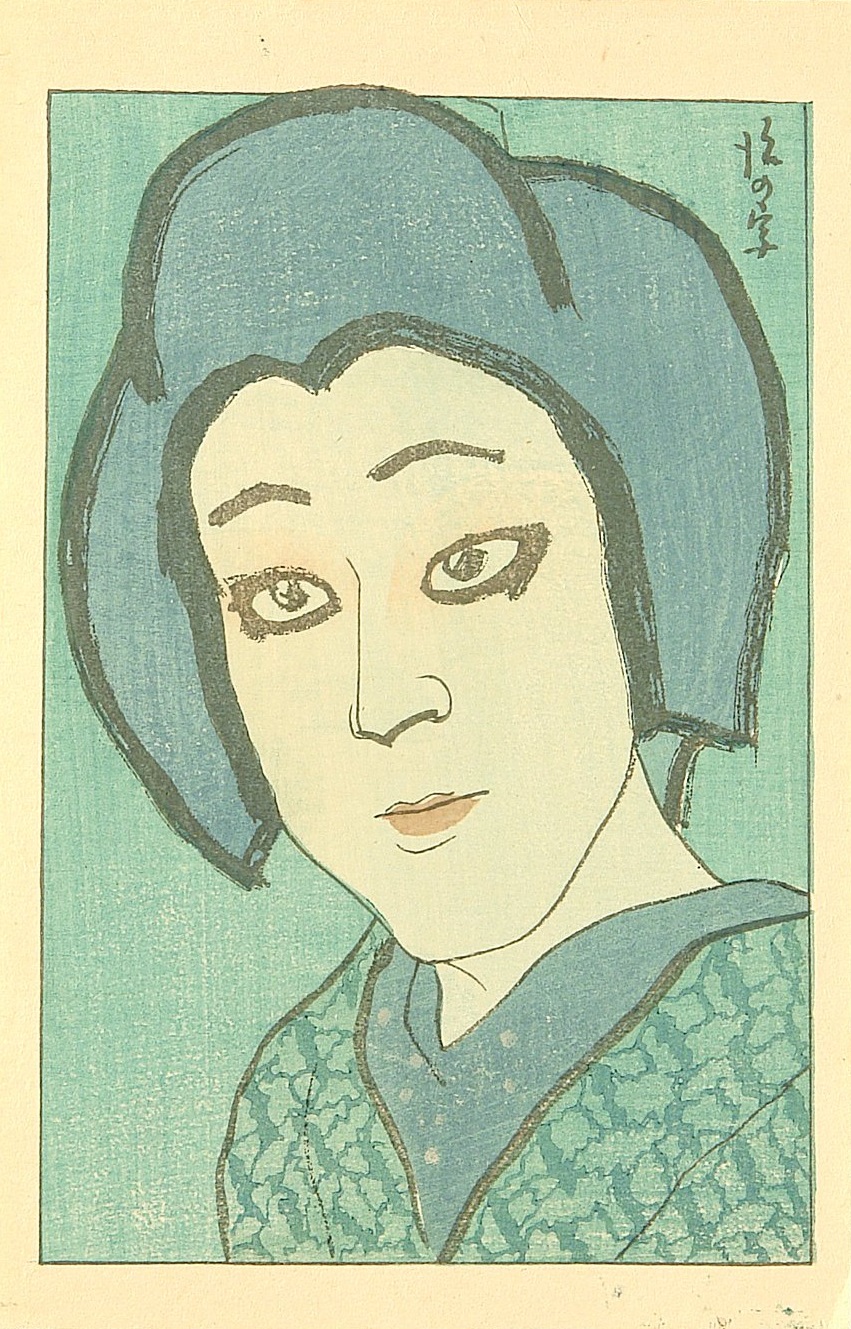
Ichikawa Sh˘ch˘ II (市川松蔦) as
Omatsu (お松)
Play: Kamiko Jitate Ry˘men Kagami
(紙子仕立両面鑑)
Performance Place: Hong˘-za, Tokyo,
Performance Date: 06/05/15
Print Date: 07/01/15
Artist: Ogawa Hy˘e (小川兵衛)
Publication: Yakusha-e (Shin Nigao)
(新似顔), Vol. 2
Personal Collection
AUGUST 1916
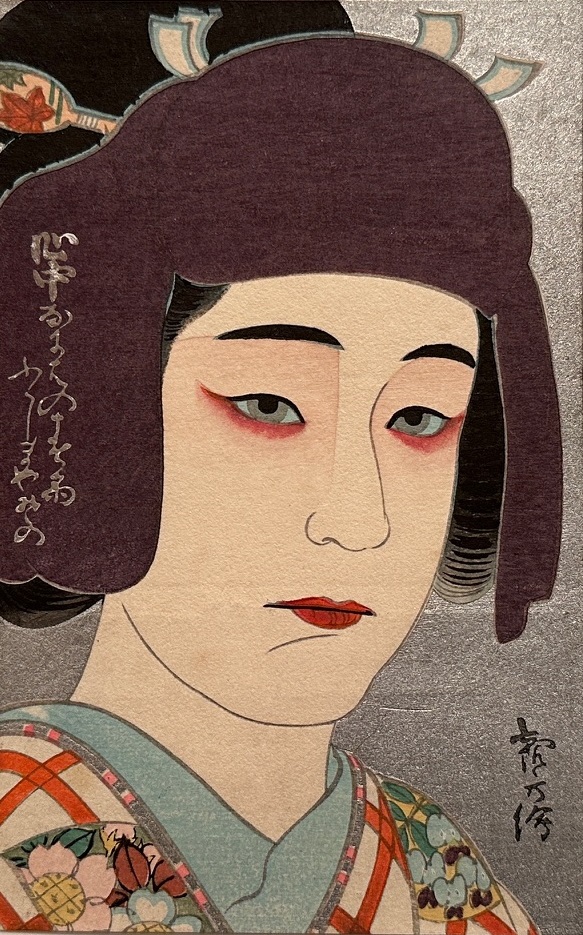
Ichikawa Sh˘ch˘ II (市川松蔦) as
Fukushimaya Osono (福島屋おその)
Play: Shinjű Naniwa no Harusame
(心中浪華春雨)
Performance Place: ?
Performance Date: ?
Print Date: 08/15/16
Artist: Yoshikawa Kanp˘ (吉川観方)
Series: [Famous Actors From East and West
Stage Picture Portraits]
T˘zai Meiyű Butai Esugata
(東西名優 舞臺絵すがた)
Medium: Woodblock printed postcard
Personal Collection
Note: Sh˘ch˘ II played this role multiple
times over the course of his career. Since
his most recent performance in Tokyo was
at the Hongo-za in January 1915, this likely
depicts a subsequent performance in Kyoto.
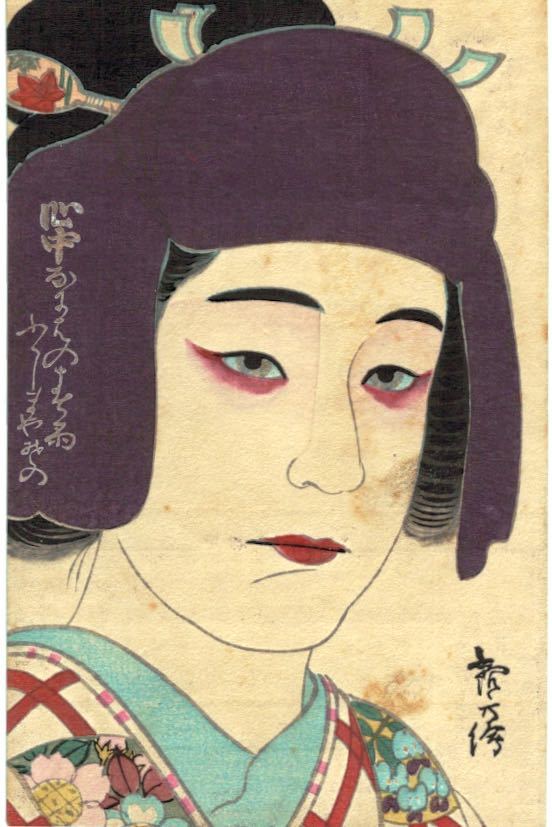
Ichikawa Sh˘ch˘ II (市川松蔦) as
Fukushimaya Osono (福島屋おその)
Play: Shinjű Naniwa no Harusame
(心中浪華春雨)
Performance Place: ?
Performance Date: ?
Print Date: 08/15/16
Artist: Yoshikawa Kanp˘ (吉川観方)
Series: [Famous Actors From East and West
Stage Picture Portraits]
T˘zai Meiyű Butai Esugata
(東西名優 舞臺絵すがた)
Medium: Woodblock printed postcard
Personal Collection
Note: This is a variant version lacking the
silver mica background.
AUGUST 1917
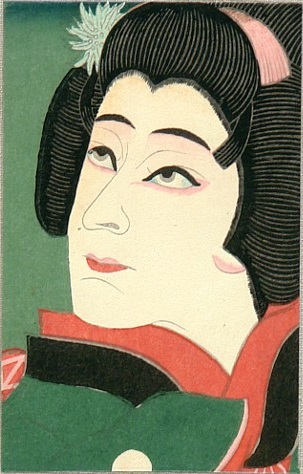
Ichikawa Sh˘ch˘ II (市川松蔦) as
Hitomaru (人丸)
Play: Hyűgajima (日向島)
Performance Place: Kabuki-za, Tokyo
Performance Date: 08/02/17
Print Date: ?
Artist: Fujisawa Tatsuo
(藤澤龍雄; 藤沢竜雄)
Medium: Woodblock printed
envelope [Fujisawa Pochibukuro Set
#A or 2?]
Personal Collection
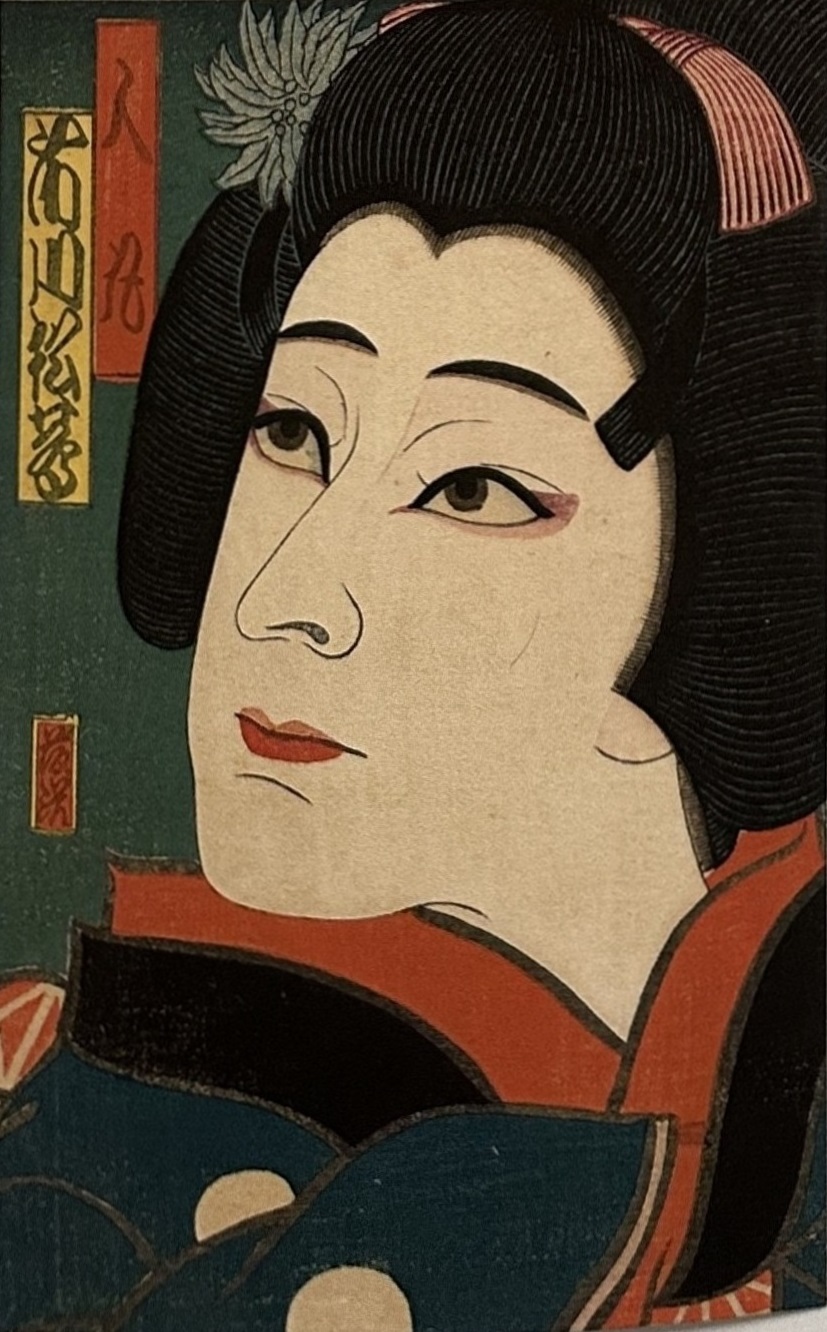
Ichikawa Sh˘ch˘ II (市川松蔦) as
Hitomaru (人丸)
Play: Hyűgajima (日向島)
Performance Place: Kabuki-za, Tokyo
Performance Date: 08/02/17
Print Date: 1917?
Artist: Fujisawa Tatsuo
(藤澤龍雄; 藤沢竜雄)
Medium: Woodblock printed
postcard
Personal Collection
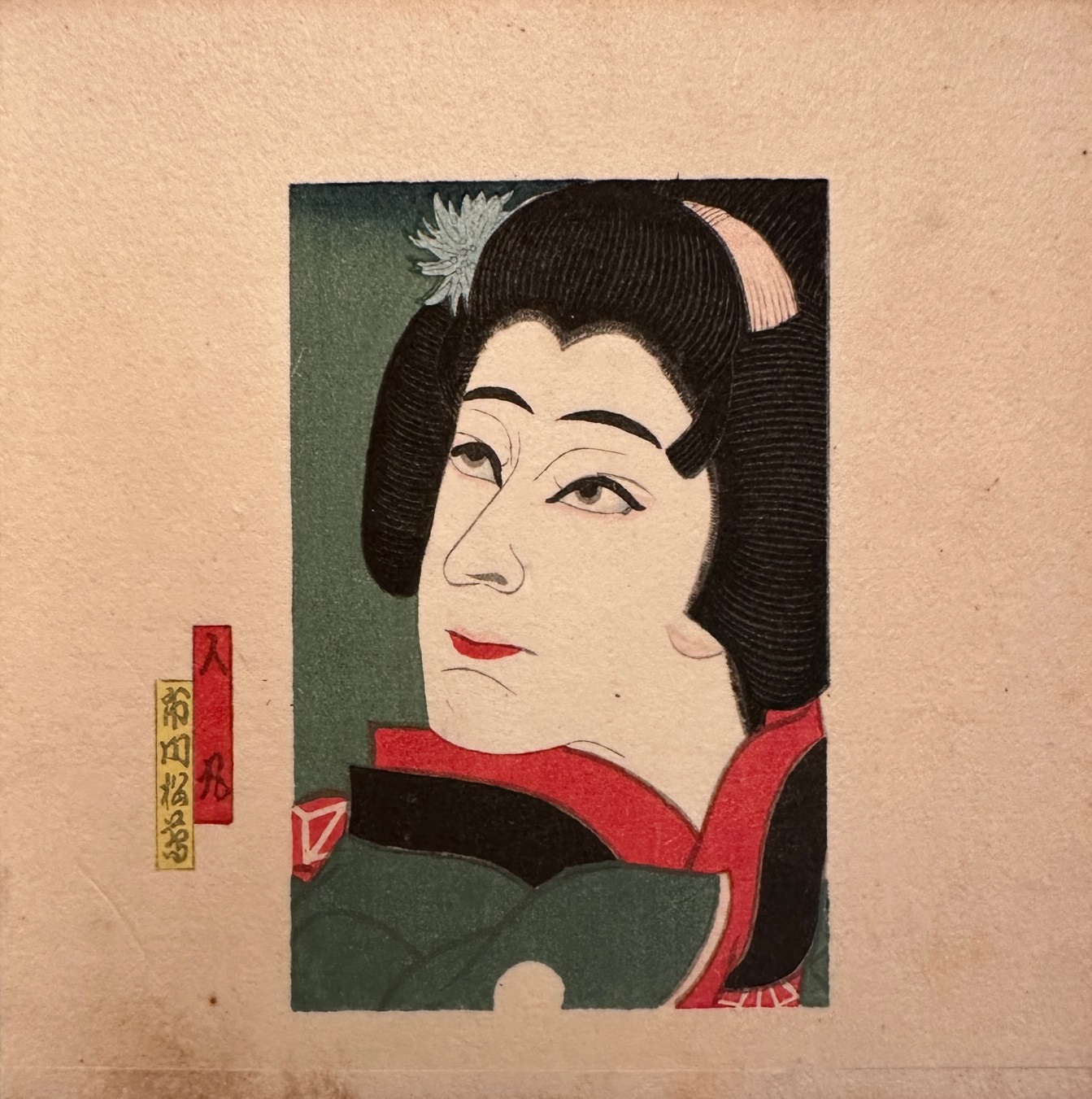
Ichikawa Sh˘ch˘ II (市川松蔦) as
Hitomaru (人丸)
Play: Hyűgajima (日向島)
Performance Place: Kabuki-za, Tokyo
Performance Date: 08/02/17
Print Date: ?
Artist: Fujisawa Tatsuo
(藤澤龍雄; 藤沢竜雄)
Medium: Woodblock print
[Fujisawa Accordion Album Set #2]
Personal Collection
Ichikawa Sadanji II (市川左団次; 市川左團次) as Aoyama Harima (青山播磨)
Ichikawa Sumiz˘ VI (市川寿美蔵; 市川壽美蔵) as H˘koma Shir˘bei (放駒四郎兵衛)
Ichikawa Sh˘ch˘ II (市川松蔦) as Okiku (お菊)
Plays: ďishi Kuranosuke (大石内蔵助); Aikokusha (愛國者); Banch˘
Sarayashiki (番町皿屋敷);
Koi Bikyaku Yamato ďrai (戀飛脚大和往来)
Performance Place: Teikoku Gekij˘, Tokyo
Performance Date: 12/01/17
Print Date: 12/1917?
Artist: Torii Kiyotada (鳥居清忠)
Medium: Woodblock printed ehon sujigaki cover
Image courtesy of the Tsubouchi Memorial Theatre Museum
Note: The cover also depicts Sawamura Gennosuke IV (沢村源之助) as
Oyoshi (およし), Kataoka
Nizaemon XI (片岡仁左衛門) as Oishi Kuranosuke (大石内蔵之助), Ichikawa
Kodanji V (市川小団次;
市川小團次) as Yoshida Chuzaemon (吉田忠左衛門), and Kataoka Ichiz˘ IV (片岡市蔵)
as Terasaka
Kichiemon (寺坂吉右衛門) in ďishi Kuranosuke (大石内蔵助); and Sawamura
S˘nosuke I (沢村宗之助;
澤村宗之助) as Umegawa (梅川) in Bikyaku Yamato ďrai (戀飛脚大和往来). The
other figure is unknown.
OCTOBER 1920
Ichikawa Sh˘ch˘ II (市川松蔦) as Oman (おまん)
Play: Imay˘ Satsuma Uta (今様薩摩歌)
Performance Place: Shintomi-za, Tokyo
Performance Date: 10/02/20
Print Date: 1920
Artist: Yamamura K˘ka (山村耕花)
*Image courtesy of the National Museum of Asian Art
DECEMBER 1920
Sawamura S˘nosuke I (沢村宗之助; 澤村宗之助) as Iinuma Katsugor˘ (飯沼勝五郎)
Ichikawa Ennosuke II (市川猿之助) as Fudesuke (筆助)
Ichikawa Sh˘ch˘ II (市川松蔦) as Hatsuhana (初花)
Plays: Sadat˘ Munet˘ (貞任宗任); Hakone Reigen Izari no Adauchi
(箱根霊験躄仇討);
Nagasone Kotetsu (長曽禰虎徹); Michiyuki Hatsune Tabi (道行初音旅)
Performance Place: Teikoku Gekij˘, Tokyo
Performance Date: 12/01/20
Print Date: 12/1920?
Artist: Torii Kiyotada (鳥居清忠)
Medium: Woodblock printed ehon sujigaki cover
Image courtesy of the Tsubouchi Memorial Theatre Museum
Note: The cover also depicts Matsumoto K˘shir˘ VII (松本幸四郎) as Abe
Jir˘ Munet˘ (阿部次郎貞任)
and Ichikawa Sadanji II (市川左団次) as Abe Sabur˘ Munet˘
(阿部三郎宗任) in Sadat˘ Munet˘
(貞任宗任); and Band˘ Jusabur˘ III (阪東壽三郎; 坂東寿三郎) as Tsubata Sen'emon
(津幡千右衛門) and
another actor in Nagasone Kotetsu (長曽禰虎徹).
JULY 1924
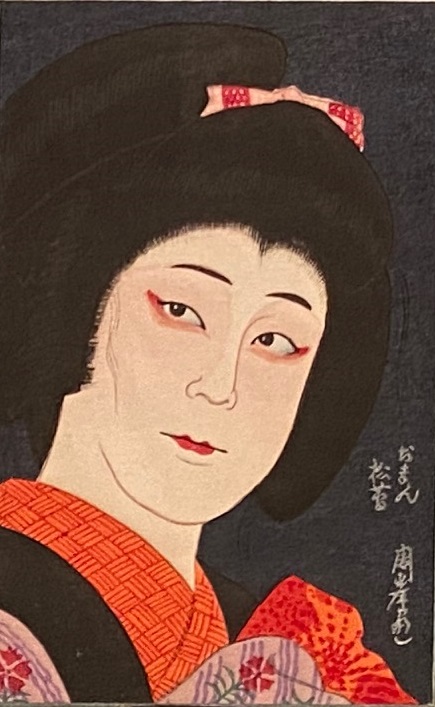
Ichikawa Sh˘ch˘ II (市川松蔦) as
Oman (おまん)
Play: Imay˘ Satsuma Uta (今様薩摩歌)
Performance Place: Asakusa Sh˘chiku-
za, Tokyo
Performance Date: 07/01/24
Print Date: 1928?
Artist: Kamishita Chikamine
(神下周峯)
Medium: Woodblock printed
pochibukuro
Series: [Images of Famous Actors of
Today] T˘sei Meiyű Omokage Z˘shi
(當世名優面影双紙) [#B]
Personal Collection
DECEMBER 1924

Ichikawa Sh˘ch˘ II (市川松蔦) as Okaru (おかる; お軽)
Play: Kanadehon Chűshingura
(仮名手本忠臣蔵; 假名手本忠臣蔵)
Performance Place: Hong˘-za, Tokyo
Performance Date: 12/1924
Print Date: 12/1924?
Artist: Miyake Hanayama (三宅花山)
Medium: Lithograph
Personal Collection
Note: Sh˘ch˘ II also portrayed Okaru in the Michiyuki
Tabiji no Hanamuko (道行旅路花聟) [Ochiudo (落人)]
dance interlude between Acts IV and V of Kanadehon
Chűshingura at the Hong˘-za in March 1924. I cannot
rule out the possibility that this print reflects Sh˘ch˘ II's
March 1924 performance.
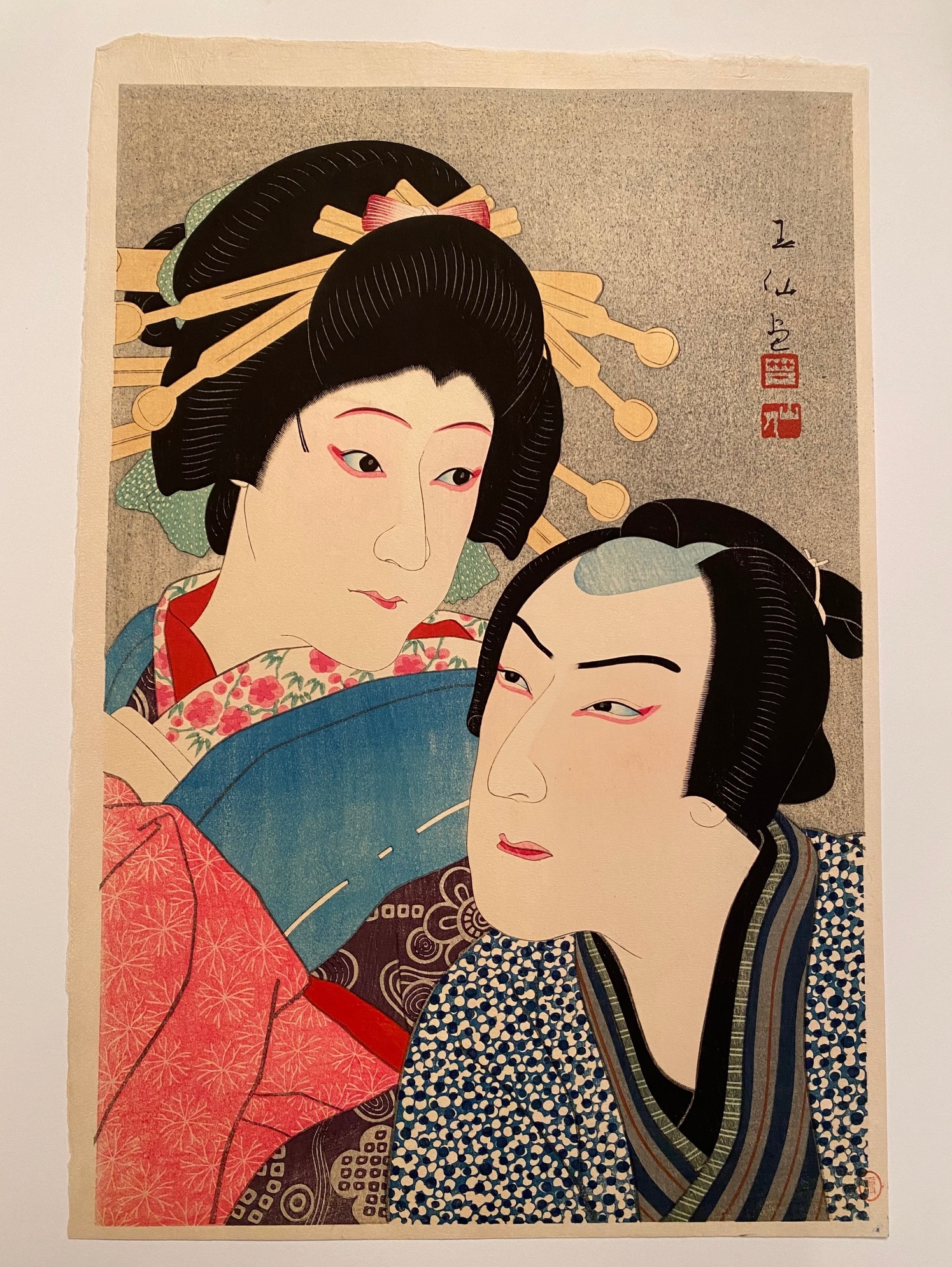
Ichikawa Sh˘ch˘ II (市川松蔦) as Umegawa (梅川)
Kataoka Gad˘ IV (片岡我童) as Chűbei (忠兵衛)
Play: Umegawa Chűbei (梅川忠兵衛), a common title for
a version of Koi Bikyaku Yamato ďrai (恋飛脚大和往来)
Performance Place: ?
Performance Date: ?
Print Date: 1927
Artist: Natori Shunsen (名取春仙)
Series: S˘saku Hanga: Shunsen Nigao-e Shű
(創作版画 春仙似顔集) (#23)
Personal Collection
Note: I have not found a specific performance with these
two actors in these roles. As a consequence, it is possible
that whatever play depicted was performed before 1927.
NOVEMBER 1937
Ichikawa Sh˘ch˘ II (市川松蔦) as
Okiku (おきく; お菊)
Play: Banch˘ Sarayashiki (番町皿屋敷)
Performance Place: Tokyo Gekij˘, Tokyo
Performance Date: 11/01/37
Print Date: 1950 or later
Artist: Ota Gat˘ (太田雅光)
Series: Meifu Miyage Geki no Omokage
(冥府苞苴劇容彩) (#21)
Medium: ?
Image courtesy of the Tsubouchi Memorial Theatre Museum
Note: It is unclear if this is a woodblock print, a watercolor
drawing, or a hand-colored keyblock print for an
unpublished design. Sh˘ch˘ II died on August 19, 1940 at
age 55. He first played the role of Okiku in Tokyo at the
Hong˘-za in February 1916. Although Sh˘ch˘ III's final
Tokyo appearance in this role was at the Tokyo Gekij˘ in
November 1937, it is possible that Gak˘ based this print
on one of Shűch˘ III's prior performances.
UNKNOWN DATES
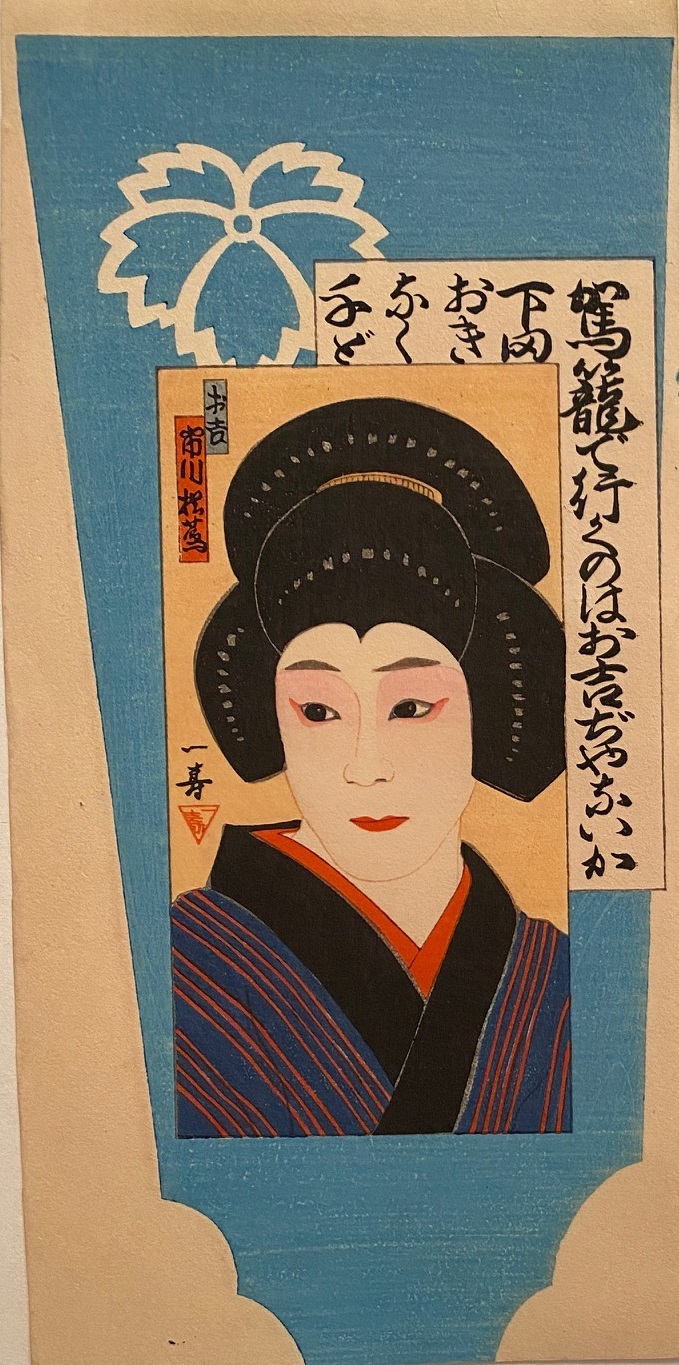
Ichikawa Sh˘chō II (市川松蔦) as
Okichi (お吉)
Play: ?
Performance Place: ?
Performance Date: ?
Print Date: ?
Artist: Miyake Hanayama (三宅花山)?
Personal Collection
Note: The signature for this print does not
appear to read "Hanayama," though the
seller of another claimed the artist was
Hanayama and was selling it with
another similar print by Hanayama
which dates to 1927. I have included it
here in an abundance of caution.
Sh˘ch˘ II played the role of Okichi in
productions of Onna Goroshi Abura no
Jigoku (女殺油地獄) at the Hong˘-za in
September 1925, T˘jin Okichi (唐人お吉)
at the Kabuki-za in August-September 1929,
and T˘jin Okichi to J˘igun
(唐人お吉と攘夷軍 at the Kabuki-za in
August 1931. It is not clear which
performance is depicted.
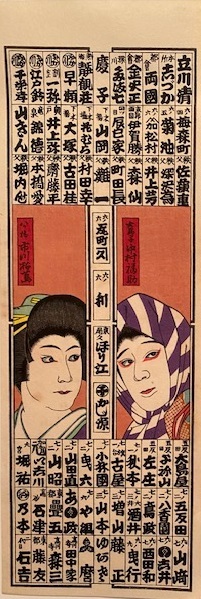
L: Ichikawa Sh˘ch˘ II (市川松蔦) as
Yatsuhashi (八ツ橋)
R: Nakamura Fukusuke V
(中村福助) as Onna Bashi (女馬子)
Play: L: Kagotsurube Sato no Eizame
(籠釣瓶花街酔醒);
R: Kiri Hitoha (桐一葉)
Performance Place: L: ?;
R: Meiji-za, Tokyo
Performance Date: L: ?; R: 04/03/21
Print Date: ?
Artist: Tanaka Shik˘ (田中紫光)
Medium: Woodblock printed
senshafuda
Personal Collection
Note: I have found records of Sh˘ch˘
II performing the role of Yatsuhashi at
the Meija-za in May 1928, at the
Kabuki-za in February 1932 and
December 1934, and at the Tokyo
Gekij˘ in May 1937, but these seem
to be too late in time given some
of the other performance dates for
other senshafuda in this series.
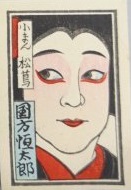
Ichikawa Sh˘ch˘ II
(市川松蔦)
as Koman (小まん)
Play: ?
Artist: ?
Medium:
Woodblock printed
matchbook
cover
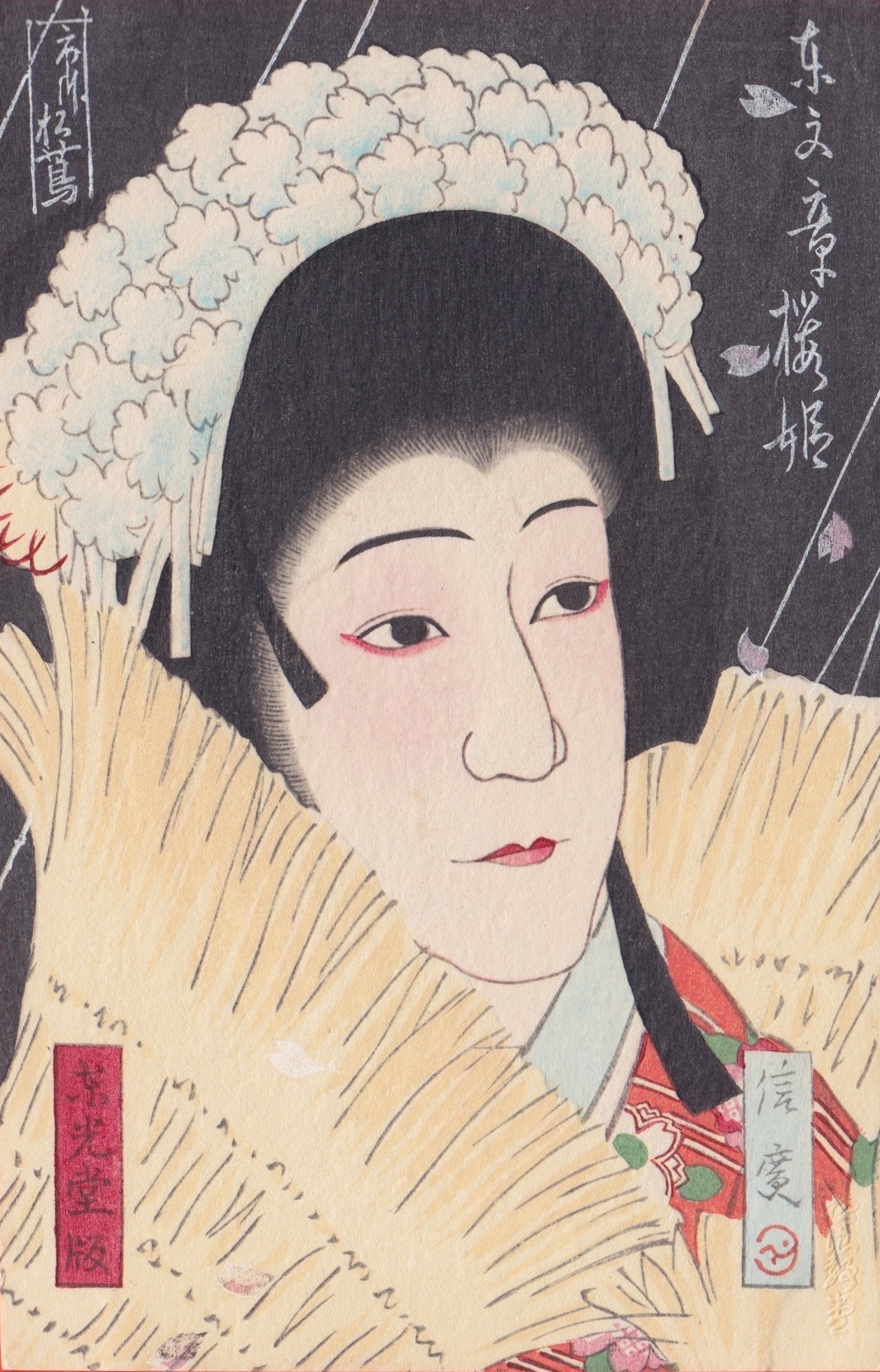
Ichikawa
Sh˘ch˘ II (市川松蔦) as
Sakura-hime (桜姫)
Play:
Sakurahime Azuma Bunsh˘
(桜姫東文章)
Performance Place: ?
Performance Date: ?
Print
Date: pre-September 1940
Artist: Hasegawa Sadanobu III
(長谷川貞信)
Medium:
Woodblock printed postcard
Image
courtesy of Gary Christenson
Note:
Ichikawa Sh˘ch˘ II performed
this role
at the Meiji-za in Tokyo in
September 1930 under the title "T˘ryű
Azuma Bunsh˘" (當流東文章). That
production likely played in Osaka or
Kyoto around that time.